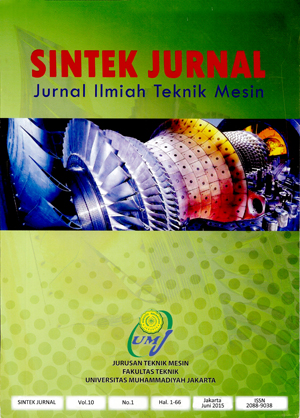PERANCANGAN BELT CONVEYOR KAPASITAS 30 TON/JAM UNTUK ALAT ANGKUT KERTAS
Main Article Content
Abstract
This plan aims to produce design and construction working drawings belt conveyor capacity 30 tons/hour in PT. Interact Corpindo as aids paper conveyance strong, sturdy, safe, and efficient so that the mobility of paper products can be run smoothly and efficiently. Conveyor Belt design process capacity of 30 tons/hour in PT. Interact Corpindo is conducted in stages, namely planning and explanation of the task/function, planning product concept (working drawings). Analysis techniques include analysis belt, idler roller, roller conveyor, motor power, the moment that occurs at the input and output shafts, gears and bearings. Conveyor Belt driving force Capacity 30 tons/hour in PT. Interact Corpindo planned to use the motor gearbox that is adapted to the results of the planning and design of 15 kW with a conveyor belt speed from 0.8 to 2 m/s. The results of the design produce a belt width of 800 mm, with a path length of 50 m.
Article Details
How to Cite
[1]
D. Cahyadi and G. F. Azis, “PERANCANGAN BELT CONVEYOR KAPASITAS 30 TON/JAM UNTUK ALAT ANGKUT KERTAS”, sintek. jurnal. ilm. teknik. mesin, vol. 9, no. 1, Apr. 2015.
Section
Articles
- Articles published in SINTEK JURNAL are licensed under a Creative Commons Attribution-ShareAlike 4.0 International license. You are free to copy, transform, or redistribute articles for any lawful purpose in any medium, provided you give appropriate credit to the original author(s) and SINTEK JURNAL, link to the license, indicate if changes were made, and redistribute any derivative work under the same license.
- Copyright on articles is retained by the respective author(s), without restrictions. A non-exclusive license is granted to SINTEK JURNAL to publish the article and identify itself as its original publisher, along with the commercial right to include the article in a hardcopy issue for sale to libraries and individuals.
- By publishing in SINTEK JURNAL, authors grant any third party the right to use their article to the extent provided by the Creative Commons Attribution-ShareAlike 4.0 International license.


